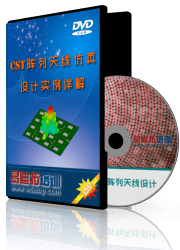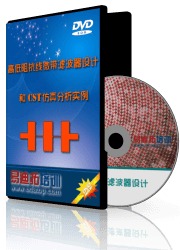- 易迪拓培训,专注于微波、射频、天线设计工程师的培养
CST2013: Adaptive Tetrahedral Mesh Refinement (Frequency Domain)
 Simulation: Solver
Simulation: Solver  Start Simulation
Start Simulation  Adaptive mesh refinement, Properties
Adaptive mesh refinement, Properties
The adaptive mesh refinement is an automatic scheme to create a mesh better suited for the given problem.
The adaptive mesh refinement properties dialog box allows you to change the parameters used for the three-dimensional adaptive mesh refinement. Please note that the adaptive mesh refinement is only active when the corresponding button is checked in the frequency domain solver parameters dialog box.
The initial mesh is automatically generated by the expert system and is used for the calculation in the first pass. See the Mesh Properties for details.
In the course of the adaptive tetrahedral mesh refinement, an estimated error of the field solution is calculated. This estimated error is calculated at the adaptation frequency samples as defined in the frequency domain solver parameters dialog box. The mesh is then refined locally where the estimated error is high. Afterwards, the mesh quality is improved. These steps are repeated until the convergence or stopping criteria are reached.
Number of passes frame
Minimum: This is the minimum number of passes that will be performed, not matter if the convergence criteria are already met or not.
Maximum: This setting determines the maximum number of passes to be performed for the mesh adaptation, even if the convergence criteria are not yet met. The maximum number of passes applies to each adaptation frequency if more than one is defined. This setting is useful to limit the total calculation time to reasonable amounts. As an example, the maximum difference of the S-parameters between two consecutive adaptive mesh refinement passes is used as the Delta S convergence criterion. Please note that a small shift in a pole location may result in a strong change of the S-parameters at the pole's frequency, especially in strongly resonant structures.
Convergence criteria frame
Convergence criteria can be checked after each discrete adaptive mesh refinement sample or after the broadband results are available. Each criterion has a Threshold associated with it, and a number of Checks. This number defines how often the criterion must fall below the Threshold in consecutive mesh adaptation passes until the convergence criterion is considered as being met.
In case of S-parameters, the criterion (Delta S) is determined as the maximum deviation of the absolute value of the complex difference of the S-parameters between two subsequent passes. All S-parameters are taken into account. The criterion may be calculated in two ways:
Checking the convergence criterion at discrete adaptation samples means that some mesh adaptation frequencies are calculated in a sequential fashion, and Delta S is used as a criterion for the adaptive mesh refinement loop at those mesh adaptation samples. It refers to the S-parameters at those particular frequencies. For each adaptation frequency, the mesh is refined several times. The broadband frequency sweep is then calculated afterwards.
In order to take into account the S-parameters in a given frequency range, the broadband frequency sweep must be applied before calculating Delta S as the maximum difference of all S-parameters in the frequency range.
In addition to the two S-parameter convergence criteria for S-parameters at discrete frequencies and for broadband S-parameters, Portmode kz/k0 and any 0D Result Template are available:
Portmode kz/k0 applies to the adaptive mesh refinement during the port mode calculation for waveguide ports. It is the maximum magnitude of the difference of the port modes' complex propagation constants kz divided by the free space propagation constant k0 between two port mesh refinement passes.
One 0D Result Template can be used as a stop criterion. The 0D result templates previously defined in the template based postprocessing dialog are available from the drop-down menu. Once a choice has been made, the name of the result template will be shown instead of 0D Result Template.
If the Resonant: Fast S-Parameter method has been chosen in the frequency domain solver parameters dialog, the Check after broadband calculation options in the convergence criteria frame are grayed out since they are not supported. The solver always checks the single frequency S-parameters at the evaluation frequency to calculate the stopping criterion in the course of the adaptive mesh refinement. These settings are shared by the General purpose and Resonant: Fast S-Parameter methods. 0D result templates and broadband S-parameters are not yet available as stopping criteria for the Resonant: Fast S-Parameter solver.
Special refinement settings frame
Snap new nodes to boundary: When this option is selected, new nodes that are generated on model interfaces during the mesh adaptation will be projected onto the original geometry, such that the approximation of curved surfaces is improved after each adaptation step. Note that if the initial mesh is very coarse and does not resolve the geometry adequately, then the snapping may fail locally. A message will be displayed in this case. To prevent this, please consider using a finer initial mesh, for example by increasing the curvature refinement.
Apply number of checks only once: This option affects simulation runs with multiple adaptation frequency samples. Usually, the convergence of the adaptive mesh refinement is checked more than once (see Checks in the Convergence criteria frame). The solver will apply this check only to the first mesh adaptation sample if this option is enabled.
Wavelength based refinement: Each edge of an element will be refined if its length is greater than the desired fraction (as defined by Steps per wavelength in the Mesh Properties) of a media wavelength at the adaptation frequency. In most cases, the initial mesh fulfills this criterion already. If the material properties are not known at the time of mesh generation, as is the case for inhomogeneously biased ferrites, then this option should be enabled.
Enhance low quality elements: If this option is enabled, the solver will re-mesh regions with very flat or needle-like elements, thereby trying to keep the mesh quality bounded from below in the course of the adaptive mesh refinement.
Refinement percentage frame
The refinement percentage is within five to thirty percent by default. The values have a twofold meaning. First, the error estimator assigns a measure for the error to each edge or element. Those mesh entities with the highest error measures are selected for refinement until their contribution to the overall estimated error is a certain percentage of the total estimated error. Second, the refinement percentage's lower and upper limits allow to roughly control the increase of the number of elements to values within the given refinement percentage range. Please note that those limits are not guaranteed because mesh quality enhancement may add or remove elements. The percentage refers to the number of elements in the mesh of the current adaptive mesh refinement pass.
Linear growth limitation: If this option is activated, the increase of the number of tetrahedrons is limited to a value which is close to the given percentage times the number of tetrahedrons in the initial mesh (before adaptive mesh refinement.)
OK
Accepts the changes and closes the dialog.
Defaults
Resets all dialog parameters to the their default settings.
Cancel
Closes this dialog box without performing any further action.
Help
Shows this help text.
See also
Frequency Domain Solver Parameters
CST微波工作室培训课程套装,专家讲解,视频教学,帮助您快速学习掌握CST设计应用
上一篇:CST2013: Asymptotic Solver Specials (SBR Raytubes)
下一篇:CST2013: Adaptive Mesh Refinement (Transient)
CST中文视频培训教程 | More...
 最全面、最专业的CST微波工作室视频培训课程,可以帮助您从零开始,全面系统学习CST的设计应用【More..】
最全面、最专业的CST微波工作室视频培训课程,可以帮助您从零开始,全面系统学习CST的设计应用【More..】
频道总排行
- CST2013: Mesh Problem Handling
- CST2013: Field Source Overview
- CST2013: Discrete Port Overview
- CST2013: Sources and Boundary C
- CST2013: Multipin Port Overview
- CST2013: Farfield Overview
- CST2013: Waveguide Port
- CST2013: Frequency Domain Solver
- CST2013: Import ODB++ Files
- CST2013: Settings for Floquet B











 沪公网安备 31011202014168号
沪公网安备 31011202014168号
 1427313829
1427313829 旺旺在线
旺旺在线 Skype Online
Skype Online 13761612886
13761612886 官方淘宝店
官方淘宝店
